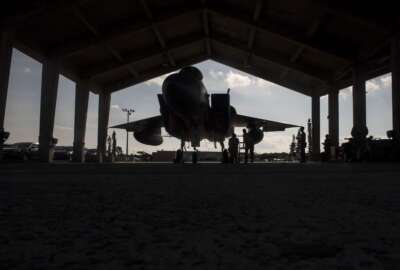

The Air Force trying new tactics to recapitalize its facilities despite a huge backlog.
Fixing things like broken toilets, leaking roofs and chipped paint aren’t the highest priority for the Air Force, especially when it’s spending billions on F-35s and modernizing its nuclear enterprise.
Despite the demands of the new national defense review, which focuses the military’s attention on near-peer competitors like China and Russia, the Air Force ended up with a 102 percent increase in the 2018 facilities, sustainment, restoration and modernization budget totaling $3.4 billion.
Now the Air Force wants to make sure it uses that money and any future money in the best possible way with a infrastructure roadmap, which is now being formulated within the service.
The Air Force is piling on $5 billion in maintenance costs a year and dealing with a $33 billion backlog already, so the bleeding isn’t going to stop anytime soon.
But Richard Hartley, the Air Force principal deputy assistant secretary for Installations, Environment and Energy, says with the roadmap the service can make the best investments possible at least lessen the pain Air Force infrastructure is feeling.
Hartley said during a June 20 speech at the Defense Communities National Summit in Washington that at this point the Air Force can’t buy its way out of the problem or even close enough bases to deal with the issue. That’s why the roadmap is imperative.
“This infrastructure strategy will be closely linked to a lot of the deputy secretary of defense’s reform agenda, specifically the chief management officer’s real property reform initiative and its focus on things like standardization, consolidation and efficiency, initiatives like contract and facility footprint, optimization, increasing utilization of our facilities, eliminating leases, demolishing buildings where we can, looking at our contracts and really scrubbing the scope and getting into strategic sourcing,” Hartley said.
The Air Force plans to expand on the CMO’s direction and initiative.
The service’s major commands will be tasked with providing infrastructure master plans.
We “are going to try to attack this infrastructure investment shortfall on multiple fronts. On one hand we are going to continue to push for sufficient resourcing, but what we are going to try to do is build out our construction task order over a five-year period,” Hartley said.
Hartley said the Air Force has been looking at metrics for years to try to make decisions and it just isn’t working. They either have a bias or aren’t showing the right type of data.
“What we think we can do now, if we really build out a requirement set and leadership is then able to take a look and see what choices they are making by taking money in or out of this account how they affect those requirements,” Hartley said. “We think we will get a little more traction, that’s really to show the impact.”
Along with the requirement sets, the strategy will look into how to better invest money and the best times to invest money into facilities and their sustainment.
Hartley likened it to an oil change. An oil change company might tell you to change your oil every 3,000 miles because they want to make money, while the car owner’s manual will say to change it every 5,000.
The Air Force wants to hit that sweet spot between maintaining facilities too early and letting them rot away.
The Air Force will have to do that possibly with less funds next year as the 2019 budget request asks for less money than the service was appropriated in 2018 at $2.9 billion.
Some may be thinking, why does it matter if paint is chipping or toilets are a little wonky when airmen really just want to get into planes that work and perform their mission?
Besides the obvious health issues, facilities management is a matter of readiness as well.
The Air Force is expanding and with expansion is the need to acquire more troops and to retain troops it already has.
One of the most well publicized shortages the Air Force is facing is the pilot shortage, currently at about 2,000.
A pilot could live on base with faulty toilets, deteriorating hangars and other facilities issues or she could leave the service after 10 years to join a major airline for a six-figure salary and use a toilet that never fails to flush.
At that point, facilities restoration and modernization goes from simply an afterthought to being at the forefront for serious personnel readiness issues.
Copyright © 2025 Federal News Network. All rights reserved. This website is not intended for users located within the European Economic Area.
Scott Maucione is a defense reporter for Federal News Network and reports on human capital, workforce and the Defense Department at-large.
Follow @smaucioneWFED

